POTOKY
The wooden church consecrated to Saint Paraskieva is of 1773. On the tower are situated the "onions" in gothic style covered by wooden shingles, to whose summit are present the decorated crosses. Nearby the church it was built the bell tower, inside it is situated the bell of 1839. In the interior of the church dominates the wooden iconostasis of 1773 with three tiers of icons. In the middle of the iconostasis is a tsar door with rich decorated wood-carvings.
LADOMIROVA
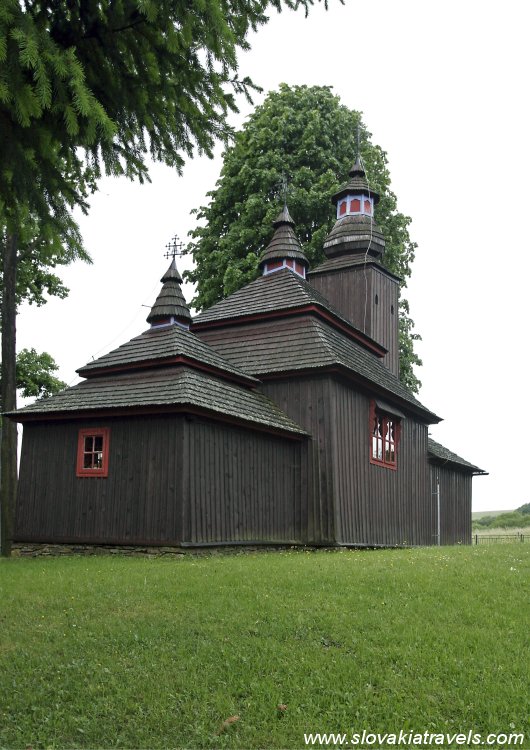 Wooden Church of eastern rite is consecrated to Archangel Michael and was built in 1742 without use of any nails. Inside the church in the western part of the nave is situated the small choir-loft, with a wooden windowsill. The iconostasis and the altar are date to 18th century. The tower and the cupolas are finished with onion-shaped spires and decorative crosses. The area of the church is put into a log fence with a interesting gate.
Wooden Church of eastern rite is consecrated to Archangel Michael and was built in 1742 without use of any nails. Inside the church in the western part of the nave is situated the small choir-loft, with a wooden windowsill. The iconostasis and the altar are date to 18th century. The tower and the cupolas are finished with onion-shaped spires and decorative crosses. The area of the church is put into a log fence with a interesting gate.
THE OPEN AIR MUSEUM SVIDNIK – SKANZEN
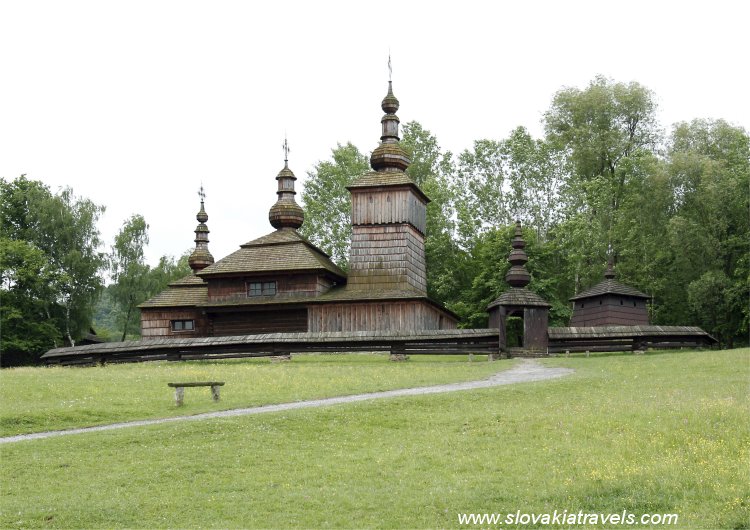
 This sacred wooden construction is of 1766 and in origin was consecrated to Saint Paraskieva. In 1986 it was transferred from the NOVA POLIANKA village to the Open-Air museum in Svidnik.
The interior walls of the original church were decorated by frescos. The iconostasis from the first part of the 18th century is not the original one, it was placed to its inside after the reconstruction of the church.
This sacred wooden construction is of 1766 and in origin was consecrated to Saint Paraskieva. In 1986 it was transferred from the NOVA POLIANKA village to the Open-Air museum in Svidnik.
The interior walls of the original church were decorated by frescos. The iconostasis from the first part of the 18th century is not the original one, it was placed to its inside after the reconstruction of the church.
SEMETKOVCE
This wooden Church is a typical three-part, log building, consecrated to Archangel Michael. It was built in 1752. Its sanctuary and nave are covered with two-hipped roofs with little conical spires. Nearby the church is anewer wooden belfry with a pyramid-shaped roof. In the sanctuary are some remains of wall paintings and the iconostasi of the 18th century. The area of the church is put into a log fence covered by the wooden tile roof.
MIROLA
Wooden Church of eastern rite consecrated to the Protection of The Mother of God is of 1770. The church dominates on the eastern slope of the village. The construction is a typical three-part, log building and its hipped roofs are finished with onion-shaped spires and forged iron crosses. The roof and the towers of the church are covered with wooden shingles. The interior decorations and the iconostasis are dated to 18th century.
KRAJNE CIERNO
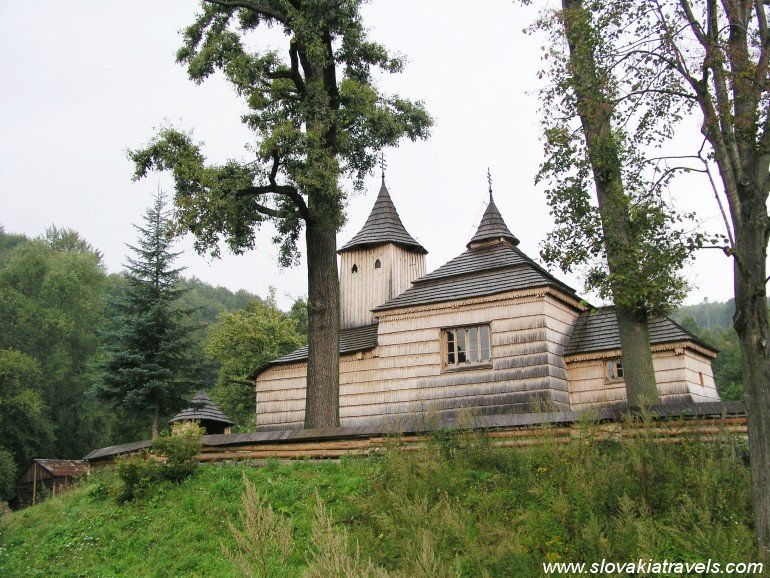 The wooden Church consecrated to Saint Bazil the Great was built in the 18th century. It is the three-part log building with and the hipped roofs are topped with conical cupolas and forged crosses. Shingles were used to cover the exterior walls of the church, except for the tower which has the usual planking. The area of the church is put into a log fence with a shingle roof and a wooden gate. Inside the church is situated the iconostasis in baroque style of the 18th century and some paintings, like for example the icon of Archangel Michael, icon of Saint Nicolas, dated to 18th century.
The wooden Church consecrated to Saint Bazil the Great was built in the 18th century. It is the three-part log building with and the hipped roofs are topped with conical cupolas and forged crosses. Shingles were used to cover the exterior walls of the church, except for the tower which has the usual planking. The area of the church is put into a log fence with a shingle roof and a wooden gate. Inside the church is situated the iconostasis in baroque style of the 18th century and some paintings, like for example the icon of Archangel Michael, icon of Saint Nicolas, dated to 18th century.
BODRUZAL
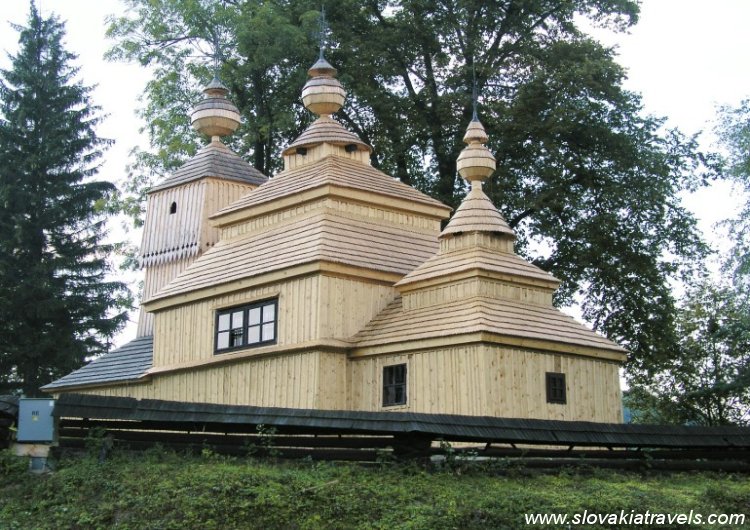 This wooden Church of eastern rite consecrated to Saint Nicolas was built in 1658 and dominates on the southern slope of the village. The construction is a typical three-part log building with a stone foundation. The sanctuary and nave are covered by a hipped roof, topped with small onion-shaped spires and forged iron crosses. The church is put into a log fence with a shingle roof. The interiors of the church is decorated in white-golden colour in the baroque style. On the northern side of the nave are some remains of wall paintings from the first half of 18th century and the iconostasis with the icons is from the end of 18th century.
This wooden Church of eastern rite consecrated to Saint Nicolas was built in 1658 and dominates on the southern slope of the village. The construction is a typical three-part log building with a stone foundation. The sanctuary and nave are covered by a hipped roof, topped with small onion-shaped spires and forged iron crosses. The church is put into a log fence with a shingle roof. The interiors of the church is decorated in white-golden colour in the baroque style. On the northern side of the nave are some remains of wall paintings from the first half of 18th century and the iconostasis with the icons is from the end of 18th century.
PRIKRA
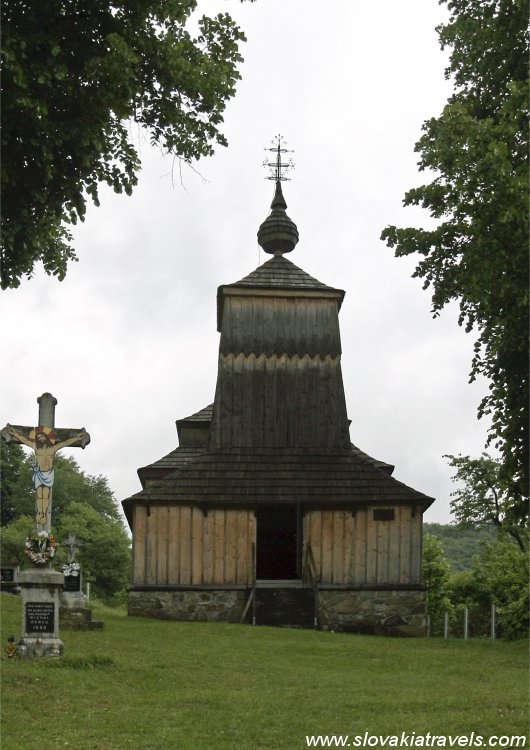 The wooden Church of eastern rite consecrated to Archangel Michael, was built in 1777 on the northern slope of the village.
The wooden Church of eastern rite consecrated to Archangel Michael, was built in 1777 on the northern slope of the village. 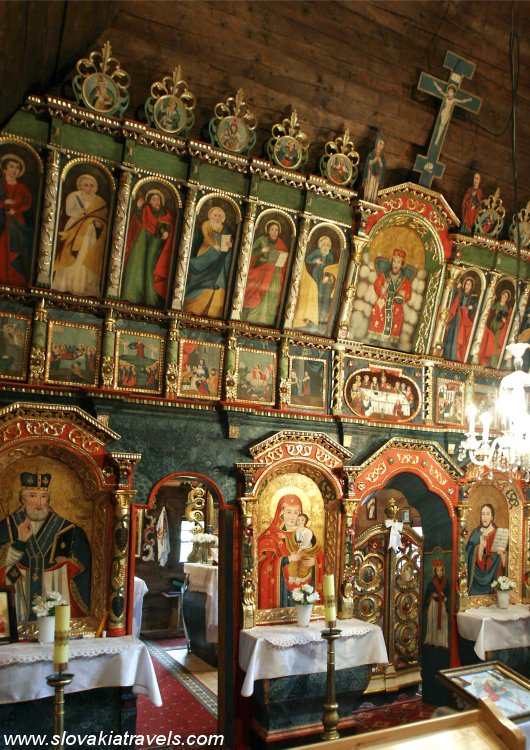 Its tower and three-hipped roofs over the nave and the sanctuary are topped with small onion spires and forged iron crosses. Inside the church are situated the iconostasis from the first half of 18th century, four candelstics in rococò style from the second half of the 18th century and some icons from the 17th century, like for example icons of St.Michael, St. Mandylion, St. Nicolas.
Its tower and three-hipped roofs over the nave and the sanctuary are topped with small onion spires and forged iron crosses. Inside the church are situated the iconostasis from the first half of 18th century, four candelstics in rococò style from the second half of the 18th century and some icons from the 17th century, like for example icons of St.Michael, St. Mandylion, St. Nicolas.
DOBROSLAVA
The wooden Church consecrated to Saint Paraskieva, was built in 1705 and restored in 1880. In 1932 the church was enlarged with two side chapels which caused a change of the original three - part groundplan to an unique five - part one (in the shape of across). The baroque interior of the church is from the 18th century. The iconostasis and the altar with the icons are of the first half of 18th century.




